

Table of contents
- cultivation without soil
- Choosing the right glass
- planting without soil
- The ideal location
- watering and fertilizing
- Conclusion
Orchids are colorful plants with unusual flower shapes. Especially in the glass, the ornamental plants appear timeless and give every location an elegant atmosphere. The cultivation and the breeding of the Orchidaceae are easy. Keeping orchids in a jar requires little effort, and you don't have to invest much time in the care yourself.
Orchids have been successfully cultivated for thousands of years. Even today, the tropical ornamental plants have lost none of their fascination. There are many ways to plant the plants in your own home. In addition to conventional planters, there is also the option of cultivating ornamental plants in glass containers. This measure is particularly beneficial for epiphytic orchid species whose roots are dependent on a lot of light. Years of experience are not necessary for this type of planting, but you should heed a few basic tips.
cultivation without soil
Orchids are a species-rich family. Some varieties have special aerial roots, which are covered by a so-called velamen radicum. The material consists of dead cells and, like a sponge, absorbs water and the nutrients dissolved in it. In the wild, epiphytic orchids prefer to grow on trees and rocky ground. Especially the lack of light on the ground has led to this way of life. This makes it possible for the plants to thrive without any substrate at all. The best-known species include Phalaenopsis and Vanda hybrids. The epiphytes are by no means among the parasitic plants.
Contrary to what is often assumed, orchids in the glass require surprisingly little care. Depending on the location and the room climate, it is sometimes even better if you leave the plants to themselves for a while. The plants will thank you with their long-lasting flowers.
Choosing the right glass
Before transplanting the orchids, you need to choose the right planter. The silvery, shiny root network of epiphytic plants needs a lot of sunlight. In addition, the aerial roots of orchids can reach an immense length of well over 60 centimeters with increasing age. The glass should be correspondingly large. Ideally, the vessel should be at least 30 to 50 centimeters high. Because of the shape, many orchid lovers swear by conical glasses. The reason: In the lower part, the roots have plenty of space to unfold, while the smaller opening prevents the humidity in the glass from escaping too quickly. An ideal climate for the tropical orchids.
The reasons for planting in the glass can be varied. The tropical ornamental plants are enjoying increasing popularity, but the sellers do not always meet the demands of the plants. Epiphytic plants are only insufficiently able to absorb sufficient moisture and vital minerals in conventional soil. Here it is only a matter of time before these orchids die off. Vanda hybrids look particularly good in tall glasses. The roots of these orchid varieties can almost reach the ground. Filling material, such as small decorative pebbles, is not absolutely necessary.
Representatives of the orchid species "Phalaenopsis", on the other hand, should not touch the bare bottom of the glass with their roots. Fill the jar with a thick layer of fine pebbles before planting the plant. To make the glass appear more decorative, you can use special decorative stones from the trade. The dye does not harm the plants and does not stain in the water.
planting without soil
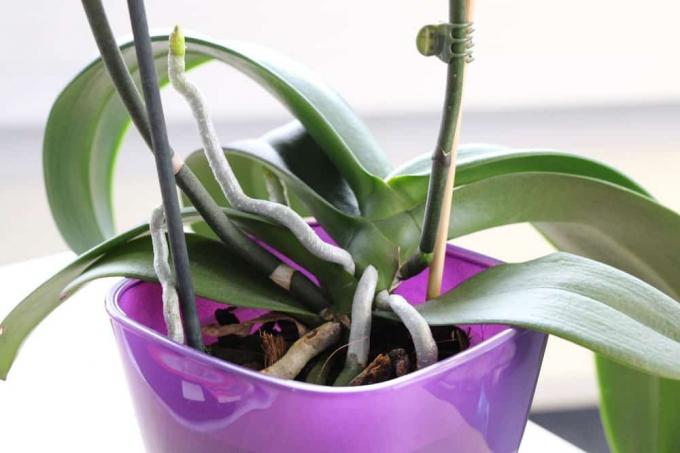
If you just want to put the orchid in a new glass jar, only a few preparations are necessary. However, the change from soil to substrate-free cultivation looks different. For this you need:
- glass jar
- Scissors
- Water
Similar to hydroponic planting, there are some difficulties involved in converting from traditional potting soil. Because the roots of the plants must be completely cleaned of the old substrate. Even the smallest residue can lead to the formation of rot due to the increased humidity in the glass vessel, which ultimately weakens the orchid and can lead to its death. Follow these steps:
- Carefully clean roots mechanically.
- Place the roots in the lukewarm water.
- Move back and forth carefully.
- If necessary, clean again with a soft brush.
Under no circumstances should the aerial roots of the orchid be damaged by this measure. Therefore, proceed as cautiously as possible. The scissors are used to shorten weak, injured or dead roots. The following applies: less is more. Because at the end there should still be enough healthy root network. If this is not guaranteed, leave the plant untouched. Particularly healthy orchids quickly get used to the change and can regenerate themselves.
Other indoor orchids can also be planted in glass, but they require constant moisture. For storage, you can use an air-permeable substrate, such as a mixture of Styrofoam, bark and peat. But seramis and expanded clay have also proven their worth.
The ideal location
The tropical ornamental plants are extremely light-requiring, but do not tolerate strong midday sun. Window sills on the east or west side, on the other hand, are very well suited and meet the light needs of tropical orchids. In winter, direct proximity to active radiators leads to irreparable leaf damage. But cold from below can also have a negative effect on the health and resilience of Orchidaceae. A 2 to 3 centimeter thick pad made of Styrofoam can help here.
In summer you can also allow the ornamental plants to stay outdoors in the decorative planters. For example, conjure up a tropical blossom atmosphere at your next social garden party or create a personal oasis of well-being on the terrace. Regardless of where you place the orchid, you should pay attention to the following points:
- Avoid direct and long-lasting sunlight.
- Avoid dark locations.
- Protect from wind and rain.
- Set up safe from rodents.
All orchids are extremely sensitive to standing moisture. With free-growing Orchidaceae, rainwater can run off or seep directly into the loose soil. In glass vessels, on the other hand, the roots are defenseless against the constantly rising water level and can suffer damage from the resulting rot. Diseases and pests also have an easy time with the weakened plants. Even regular watering is not enough. As a precaution, you should therefore house orchids outdoors in a covered area.
watering and fertilizing
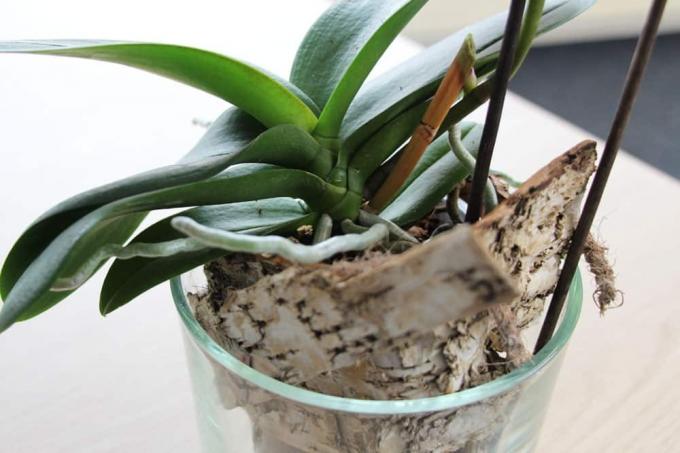
Each orchid species has different requirements when it comes to the right supply of water and nutrients. With Vanda hybrids it is sufficient if you put the orchids in a water bath up to the upper root neck about every 4 to 5 days. The immersion bath can take place directly in the glass container and should last a maximum of a few minutes. Then immediately pour out the water completely. Even the robust hybrids cannot tolerate waterlogging. In the time until the next dive, the plants "feed" on the residual moisture and in the roots.
Phalaenopsis likes to draw on a constant supply of water, but without the plant itself coming into contact with it. The pebbles in the glass ensure that the orchid keeps its feet dry, the water is absorbed by the high humidity inside the glass. Here, too, you should make sure when watering that the water level in the container does not touch the roots of the plant.
Tip:
Spray the leaves of the orchids regularly with a fine water spray. This protects the plants from overheating, especially in warm locations.
Even if all orchid plants differ in terms of care, you can still fall back on the following tips:
- Bulbous orchids should be almost dry before the next watering.
- Only use lime-free water at room temperature.
- Distilled water also benefits the plants.
Use a special fertilizer for orchids. This contains all the important minerals that promote the flowering power and resistance of tropical plants. When and how often you fertilize also depends on the chosen orchid species. The fertilizer is administered directly via the irrigation water.
Conclusion
Cultivating the tropical ornamental plants in a glass without soil is by no means a modern way of keeping plants. Rather, in this way you meet the requirements of many orchid varieties whose roots are dependent on light. In addition to choosing the ideal glass jar, the location and the right care also contribute to the well-being of the exotic flowering plants. Keeping orchids successfully is not only reserved for experienced hobby gardeners, but you should never take the demands of the plants lightly.
 garden editorial
garden editorial I write about everything that interests me in my garden.
Learn more about caring for plants
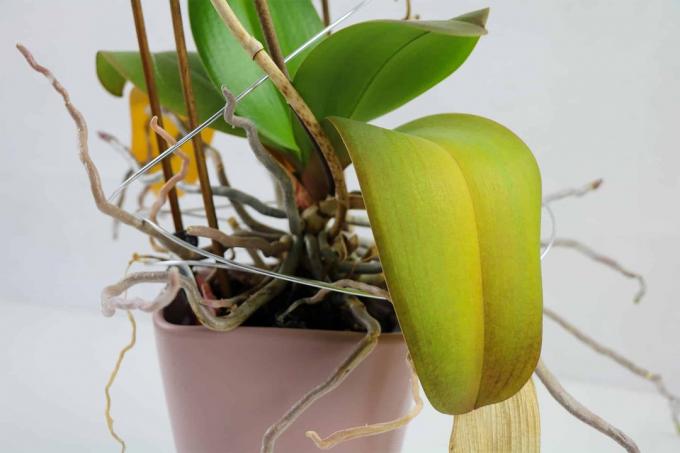
Plant hangs leaves despite water
If plants let their leaves hang despite water, this can have various causes. In order to prevent it from dying off by taking rapid countermeasures, you should find out about the possible causes and effective countermeasures here.
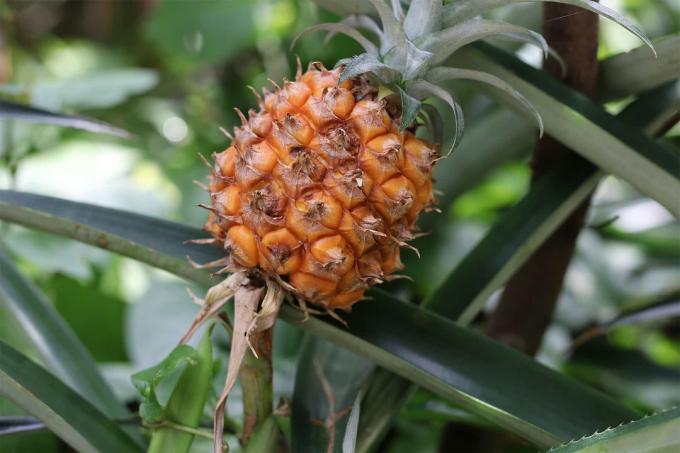
Plants hang their heads: what to do?
If the ornamental plants are cultivated in the garden or in pots and suddenly let their heads droop, then the question quickly arises as to why this can be. However, this is usually due to maintenance errors that need to be checked. If a remedy is found, most plants usually recover quickly.

Repot orchids: how & when to replant
Thanks to more uncomplicated and easy-care new breeds, orchids are now at home on many windowsills. In particular, the Phalaenopsis or butterfly orchid, which is available in countless varieties, is very popular. Read how and when you can best repot the distinctive beauties.

pull tree out of core | 7 tips for growing a tree yourself
Trees can be grown from cores without much effort. There are a variety of plants that have seeds and can be easily cultivated in your own garden. Special classic fruit trees should be mentioned, which are suitable for such a project.
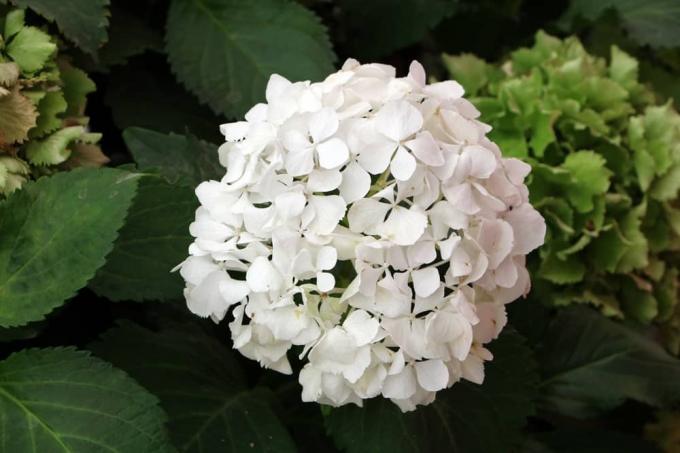
How do hydrangeas stay white? | That way it won't turn pink
How do hydrangeas stay white - this is the question many hobby gardeners ask themselves when the hydrangea changes color. The white often turns into a pink, which is usually comparatively pale or can appear "dirty". Here we reveal how it works.
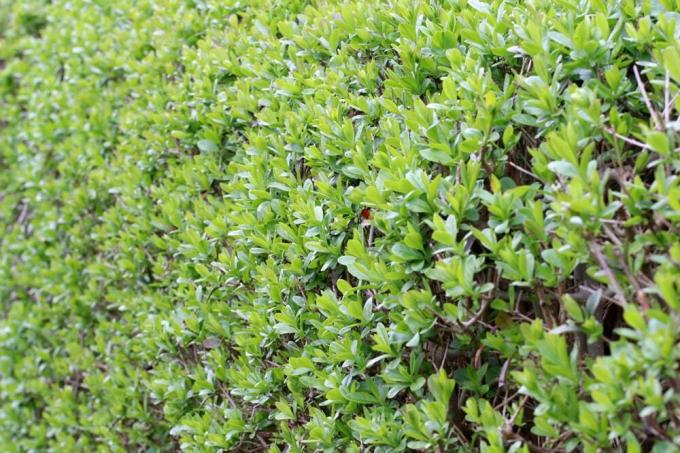
Cutting privet: when is the best time?
Privet is becoming increasingly popular and is often used as a privacy screen in the form of a privet hedge. This is not surprising, because the plant is easy to care for and fast-growing. However, it is crucial to cut the plant regularly at the right time.

